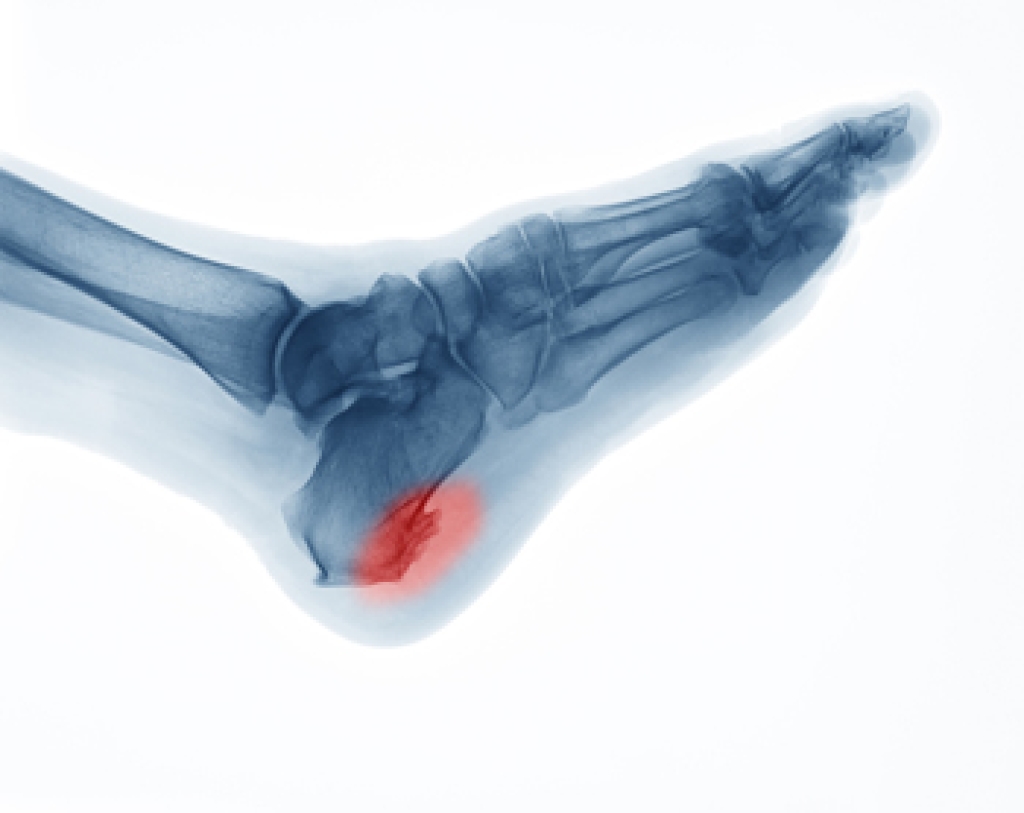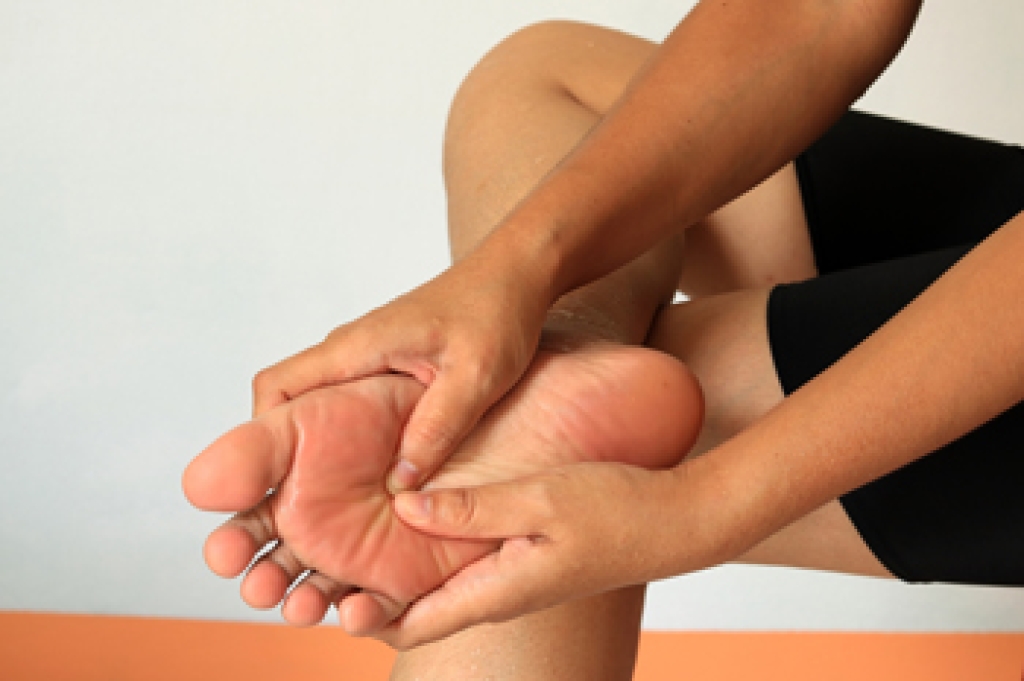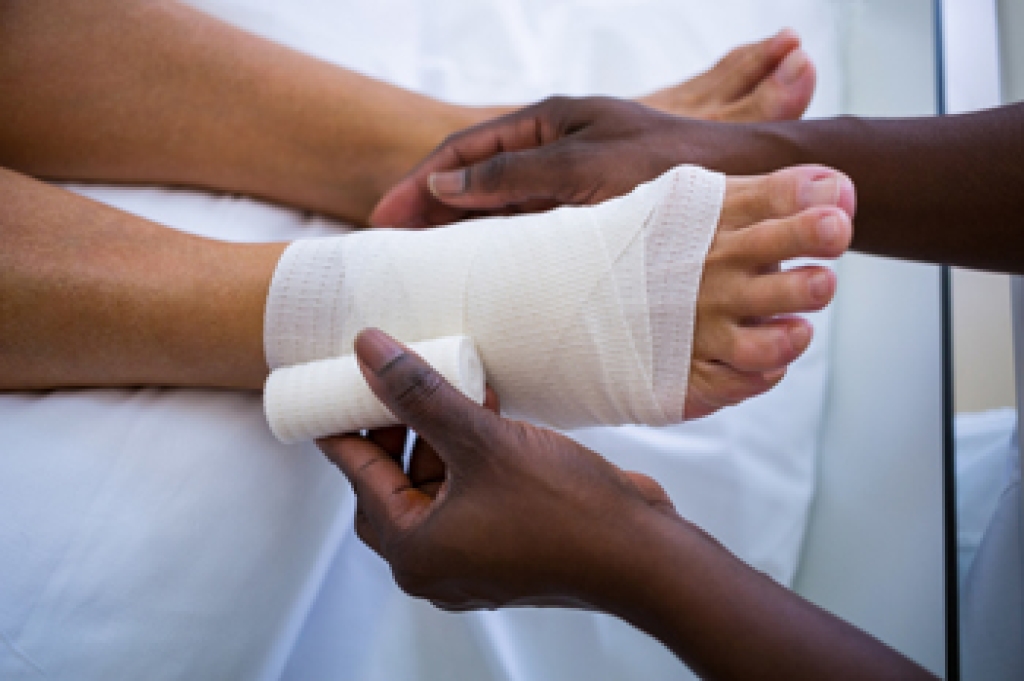Connect With Us
Blog
Blog
What Condition Can a Heel Spur Be Linked To?
 A heel spur is defined as a portion of bone that develops where the plantar fascia connects to the heel bone. It is often linked to the medical condition that is known as plantar fasciitis, which can cause severe pain and discomfort. Mild relief may be found when extra weight is lost and this may ease the pressure on the heel. There are some patients that find it helpful to use shoe inserts, or to wear a night splint. This may alleviate some of the pain that a heel spur can cause. The healing process may be accelerated when the affected foot is rested, and when regular running activities have temporarily stopped. If you have pain in your heel, it is strongly recommended that you consult with a podiatrist who can diagnose and treat this condition.
A heel spur is defined as a portion of bone that develops where the plantar fascia connects to the heel bone. It is often linked to the medical condition that is known as plantar fasciitis, which can cause severe pain and discomfort. Mild relief may be found when extra weight is lost and this may ease the pressure on the heel. There are some patients that find it helpful to use shoe inserts, or to wear a night splint. This may alleviate some of the pain that a heel spur can cause. The healing process may be accelerated when the affected foot is rested, and when regular running activities have temporarily stopped. If you have pain in your heel, it is strongly recommended that you consult with a podiatrist who can diagnose and treat this condition.
Heel spurs can be incredibly painful and sometimes may make you unable to participate in physical activities. To get medical care for your heel spurs, contact one of our podiatrists from APEX Foot & Ankle Center. Our doctors will do everything possible to treat your condition.
Heels Spurs
Heel spurs are formed by calcium deposits on the back of the foot where the heel is. This can also be caused by small fragments of bone breaking off one section of the foot, attaching onto the back of the foot. Heel spurs can also be bone growth on the back of the foot and may grow in the direction of the arch of the foot.
Older individuals usually suffer from heel spurs and pain sometimes intensifies with age. One of the main condition's spurs are related to is plantar fasciitis.
Pain
The pain associated with spurs is often because of weight placed on the feet. When someone is walking, their entire weight is concentrated on the feet. Bone spurs then have the tendency to affect other bones and tissues around the foot. As the pain continues, the feet will become tender and sensitive over time.
Treatments
There are many ways to treat heel spurs. If one is suffering from heel spurs in conjunction with pain, there are several methods for healing. Medication, surgery, and herbal care are some options.
If you have any questions, please feel free to contact our offices located in Fort Myers, Shellpoint, and Naples, FL . We offer the newest diagnostic and treatment technologies for all your foot care needs.
Possible Foot Conditions During Pregnancy
 Half of women who are pregnant often notice changes in their feet. A common ailment can be collapsed arches, and this may be a result of the added weight the feet must endure during pregnancy. The feet generally become more flexible, and this may put strain on the ligaments, tendons, and muscles. Relief may be found when comfortable shoes are worn, and this may help to support the overall foot. Many women notice they have general foot pain, and the pain can exist in the arch and heel. This may be indicative of the condition that is known as plantar fasciitis, and may improve when specific foot stretches are performed. If you would like additional information on how your feet can feel better during pregnancy, please consult with a podiatrist.
Half of women who are pregnant often notice changes in their feet. A common ailment can be collapsed arches, and this may be a result of the added weight the feet must endure during pregnancy. The feet generally become more flexible, and this may put strain on the ligaments, tendons, and muscles. Relief may be found when comfortable shoes are worn, and this may help to support the overall foot. Many women notice they have general foot pain, and the pain can exist in the arch and heel. This may be indicative of the condition that is known as plantar fasciitis, and may improve when specific foot stretches are performed. If you would like additional information on how your feet can feel better during pregnancy, please consult with a podiatrist.
Pregnant women with swollen feet can be treated with a variety of different methods that are readily available. For more information about other cures for swollen feet during pregnancy, consult with one of our podiatrists from APEX Foot & Ankle Center. Our doctors will attend to all of your foot and ankle needs.
What Foot Problems Can Arise During Pregnancy?
One problem that can occur is overpronation, which occurs when the arch of the foot flattens and tends to roll inward. This can cause pain and discomfort in your heels while you’re walking or even just standing up, trying to support your baby.
Another problem is edema, or swelling in the extremities. This often affects the feet during pregnancy but tends to occur in the later stages.
How Can I Keep My Feet Healthy During Pregnancy?
- Wearing orthotics can provide extra support for the feet and help distribute weight evenly
- Minimize the amount of time spent walking barefoot
- Wear shoes with good arch support
- Wear shoes that allow for good circulation to the feet
- Elevate feet if you experience swelling
- Massage your feet
- Get regular, light exercise, such as walking, to promote blood circulation to the feet
If you have any questions, please feel free to contact our offices located in Fort Myers, Shellpoint, and Naples, FL . We offer the newest diagnostic and treatment technologies for all your foot care needs.
What Is Cuboid Syndrome?
 The cuboid bone is a cube-shaped bone located on the outer side of the foot. When this bone is displaced due to overuse or an ankle sprain, a condition called cuboid syndrome develops. This is a very common injury in athletes and ballet dancers and represents 4% of all foot injuries. Cuboid syndrome typically causes pain in the outer side of the foot and other symptoms can include difficulty walking, running, and jumping. The most effective treatment for this condition is to restore the cuboid bone to its correct position via cuboid manipulation. Taping the cuboid bone or doing simple foot exercises may also help with the pain. If you suspect that you have cuboid syndrome, it is recommended that you seek the care of a podiatrist who can properly diagnose this condition and offer treatment techniques that are best for you.
The cuboid bone is a cube-shaped bone located on the outer side of the foot. When this bone is displaced due to overuse or an ankle sprain, a condition called cuboid syndrome develops. This is a very common injury in athletes and ballet dancers and represents 4% of all foot injuries. Cuboid syndrome typically causes pain in the outer side of the foot and other symptoms can include difficulty walking, running, and jumping. The most effective treatment for this condition is to restore the cuboid bone to its correct position via cuboid manipulation. Taping the cuboid bone or doing simple foot exercises may also help with the pain. If you suspect that you have cuboid syndrome, it is recommended that you seek the care of a podiatrist who can properly diagnose this condition and offer treatment techniques that are best for you.
Cuboid syndrome, also known as cuboid subluxation, occurs when the joints and ligaments near the cuboid bone in the foot become torn. If you have cuboid syndrome, consult with one of our podiatrists from APEX Foot & Ankle Center. Our doctors will assess your condition and provide you with quality foot and ankle treatment.
Cuboid syndrome is a common cause of lateral foot pain, which is pain on the outside of the foot. The condition may happen suddenly due to an ankle sprain, or it may develop slowly overtime from repetitive tension through the bone and surrounding structures.
Causes
The most common causes of cuboid syndrome include:
- Injury – The most common cause of this ailment is an ankle sprain.
- Repetitive Strain – Tension placed through the peroneus longus muscle from repetitive activities such as jumping and running may cause excessive traction on the bone causing it to sublux.
- Altered Foot Biomechanics – Most people suffering from cuboid subluxation have flat feet.
Symptoms
A common symptom of cuboid syndrome is pain along the outside of the foot which can be felt in the ankle and toes. This pain may create walking difficulties and may cause those with the condition to walk with a limp.
Diagnosis
Diagnosis of cuboid syndrome is often difficult, and it is often misdiagnosed. X-rays, MRIs and CT scans often fail to properly show the cuboid subluxation. Although there isn’t a specific test used to diagnose cuboid syndrome, your podiatrist will usually check if pain is felt while pressing firmly on the cuboid bone of your foot.
Treatment
Just as the range of causes varies widely, so do treatments. Some more common treatments are ice therapy, rest, exercise, taping, and orthotics.
If you have any questions, please feel free to contact our offices located in Fort Myers, Shellpoint, and Naples, FL . We offer the newest diagnostic and treatment technologies for all your foot care needs.
Decreasing Amputation Risk in Patients With Diabetic Foot Ulcers
Diabetic foot ulcers can increase a patient’s risk of lower limb amputation. However, with proper care, amputation may be prevented. There are various approaches that may help decrease the risk of amputations and improve the quality of life for a patient with diabetic foot ulcers. These approaches include monitoring the feet for any breaks in the skin, screening the patient for neuropathy (a condition that causes a reduction or loss of sensation in the feet), following guidelines for treating foot ulcer infections, removing dead tissue and debris from the affected foot, and relieving pressure from the part of the foot that is ulcerated. For more information about decreasing the risk of amputation due to diabetic foot ulcers, it is recommended that you consult with a podiatrist today.
Limb salvage can be an effective way in preventing the need for limb amputation. If you have diabetes, cancer, or any other condition that could lead to foot amputation if left unchecked, consult with one of our podiatrists from APEX Foot & Ankle Center. Our doctors will assess your condition and provide you with quality foot and ankle treatment.
What Is Limb Salvage?
Limb salvage is the attempt of saving a limb, such as the foot from amputation. Podiatrists also try to make sure that there is enough function in the foot after the salvage that it is still usable. Diabetes is the number one cause of non-traumatic amputations in the United States. Those with diabetes experience poor blood circulation, which prevents proper healing of an ulcer. If the ulcer is left uncheck, it could become infected, which could result in the need for amputation.
However, there are other causes as well, such as cancer and traumatic injury. Links between higher mortality rates and amputation have been found. This translates into higher healthcare costs, and a reduced quality of life and mobility for amputees. Podiatrists have attempted to increase the prevalence of limb salvage in an attempt to solve these issues.
Diagnosis and Treatment
Limb salvage teams have grown in recent years that utilize a number of different treatments to save the infected limb. This includes podiatrists that specialize in wound care, rehabilitation, orthotics, and surgery. Through a combination of these methods, limb salvage has been found to be an effective treatment for infected limbs, and as an alternative to amputation. Podiatrists will first evaluate the potential for limb salvage and determine if the limb can be saved or must be amputated.
If you have any questions, please feel free to contact our offices located in Fort Myers, Shellpoint, and Naples, FL . We offer the newest diagnostic and treatment technologies for all your foot care needs.
Blog Archives
- 2025
- 2024
- 2023
- 2022
- 2021
- 2020
- 2019
- 2018
- 2017


